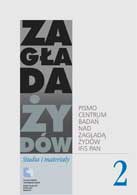Menu
- Main Page
- About us
- Research
- Publications
- Links
- Contact
- Archiwum
- Holocaust. Studies and Materials
the Center's Journal - NIGHT WITHOUT AND END - »FAILED CORRECTION«
- Wybór źródeł
- EHRI PL
News
Programme of Center's academic seminars for winter term 2025
We are pleased to announce the return of our scientific seminar series in less than a month, and warmly invite all interested parties to attend. The seminars will be held on the second or third Wednesday of each month, both in person at the Institute of Philosophy and Sociology of the Polis...
M. Turski Historical Award of Polityka for Justyna Majewska
It is with undisguised pride we report that our colleague Dr. Justyna Majewska has been awarded the Marian Turski POLITYKA Historical Prize for her book debut, "Mury i szczeliny. Przestrzenie getta warszawskiego /Walls and Slits. Spaces of the Warsaw Ghetto". We are very happy and...
Call for Articles - Holocaust Studies and Materials 2026
Call for Articles 2026 Call for Articles Connecting scholarly reflection on the Holocaust to the present - new sources and technologies in research The past decade has seen a breakthrough in Holocaust research, both in terms of the availability of archival sources and the digital ...
Farewell to Marian Turski
It is with profound sorrow that we bid farewell to Marian Turski—a distinguished journalist, historian, and Survivor. An extraordinary man whose voice resonated deeply, he not only shared the lessons of the past but actively championed courage, solidarity, and empathy in the face of evil. ...
Center in EHRI PL consortium
Polish Center for Holocaust Research of the Institute of Philosophy and Sociology of the Polish Academy of Sciences, together with the E. Ringelblum Jewish Historical Institute and the Center for Jewish Studies of the University of Lodz, are creating a national node of the European Holocaust Research Infrastructure within the framework of ERIC
NEWSLETTER
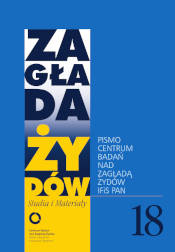 Zagłada Żydów.
Zagłada Żydów.
Studia i Materiały
nr 18, R. 2022
Warszawa 2022
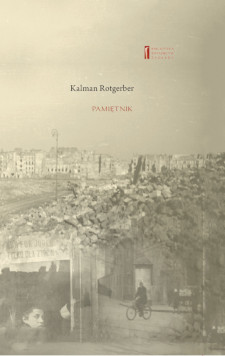 PAMIĘTNIK
PAMIĘTNIK
Kalman Rotgeber
oprac. Aleksandra Bańkowska, wstęp Jacek Leociak
Warszawa 2021
Zagłada Żydów.
Studia i Materiały
nr 17, R. 2021
Warszawa 2021
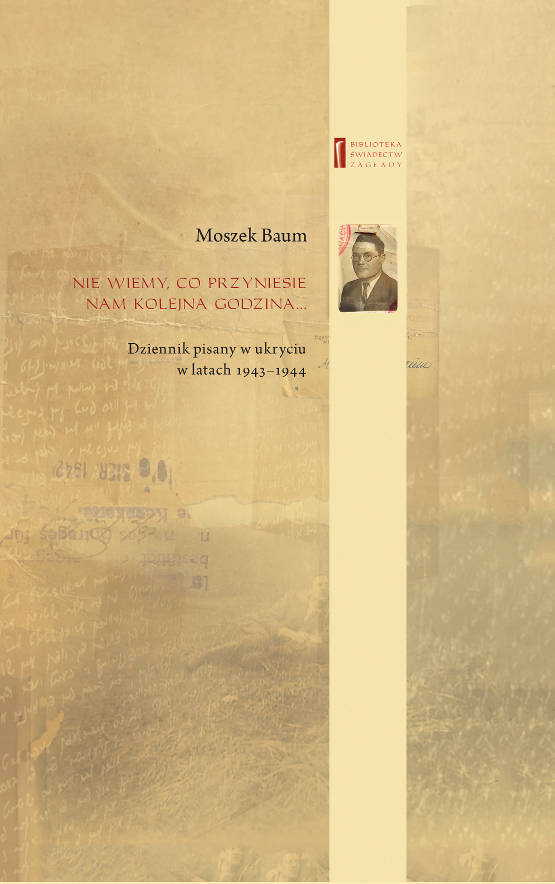 NIE WIEMY CO PRZYNIESIE NAM KOLEJNA GODZINA ...
NIE WIEMY CO PRZYNIESIE NAM KOLEJNA GODZINA ...
Dziennik pisany w ukryciu w latach 1943-1944
Moszek Baum, oprac. Barbara Engelking, tłum. z jidysz Monika Polit
Warszawa 2020
Zagłada Żydów.
Studia i Materiały
nr 16, R. 2020
Warszawa 2020
.jpg) Aryjskiego Żyda wspomnienia, łzy i myśli
Aryjskiego Żyda wspomnienia, łzy i myśli
Zapiski z okupacyjnej Warszawy
Sewek Okonowski, oprac. Marta Janczewska
 PISZĄCY TE SŁOWA JEST PRACOWNIKIEM
PISZĄCY TE SŁOWA JEST PRACOWNIKIEM
GETTOWEJ INSTYTUCJI ...
'z Dziennika' i inne pisma z łódzkiego getta
Józef Zelkowicz, tłum. z jidysz, oprac. i wstęp. Monika Polit
Warszawa 2019
CZYTAJĄC GAZETĘ NIEMIECKĄ ...
Dziennik pisany w ukryciu w Warszawie w latach 1943-1944
Jakub Hochberg, oprac. i wstępem opatrzyła Barbara Engelking
Warszawa 2019
Zagłada Żydów.
Studia i Materiały
nr 15, R. 2019
Warszawa 2019
.jpg) Zagłada Żydów.
Zagłada Żydów.
Studia i Materiały
nr 14, R. 2018
Warszawa 2018
 DALEJ JEST NOC. Losy Żydów w wybranych powiatach okupowanej Polski
DALEJ JEST NOC. Losy Żydów w wybranych powiatach okupowanej Polski
red. i wstęp Barbara Engelking, Jan Grabowski
Warszawa 2018
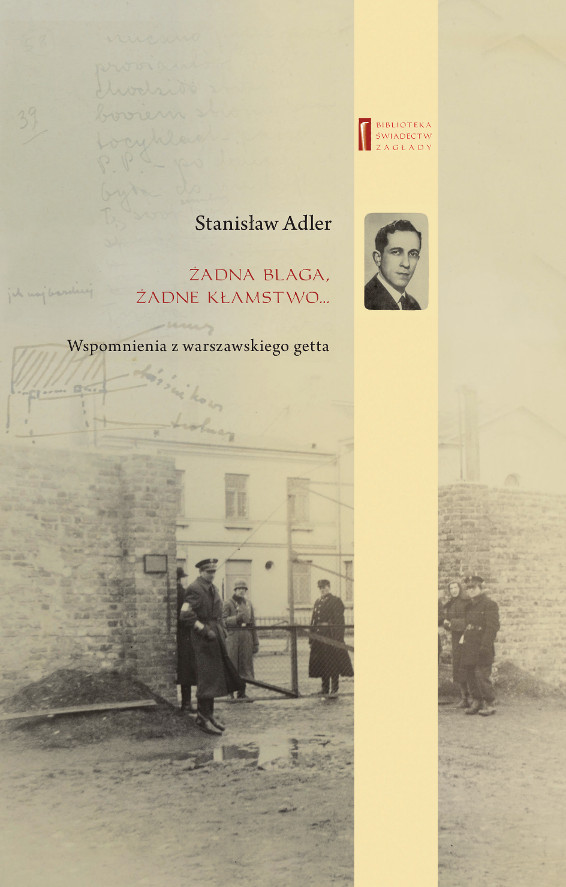 ŻADNA BLAGA, ŻADNE KŁAMSTWO ...
ŻADNA BLAGA, ŻADNE KŁAMSTWO ...
Wspomnienia z warszawskiego getta
Stanisław Adler, oprac. i wstępem opatrzyła Marta Janczewska
Warszawa 2018
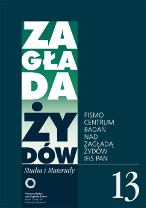 Zagłada Żydów.
Zagłada Żydów.
Studia i Materiały
nr 13, R. 2017
Warszawa 2017
 TYLEŚMY JUŻ PRZESZLI ...
TYLEŚMY JUŻ PRZESZLI ...
Dziennik pisany w bunkrze (Żółkiew 1942-1944)
Clara Kramer, oprac. i wstępem opatrzyła Anna Wylegała
Warszawa 2017
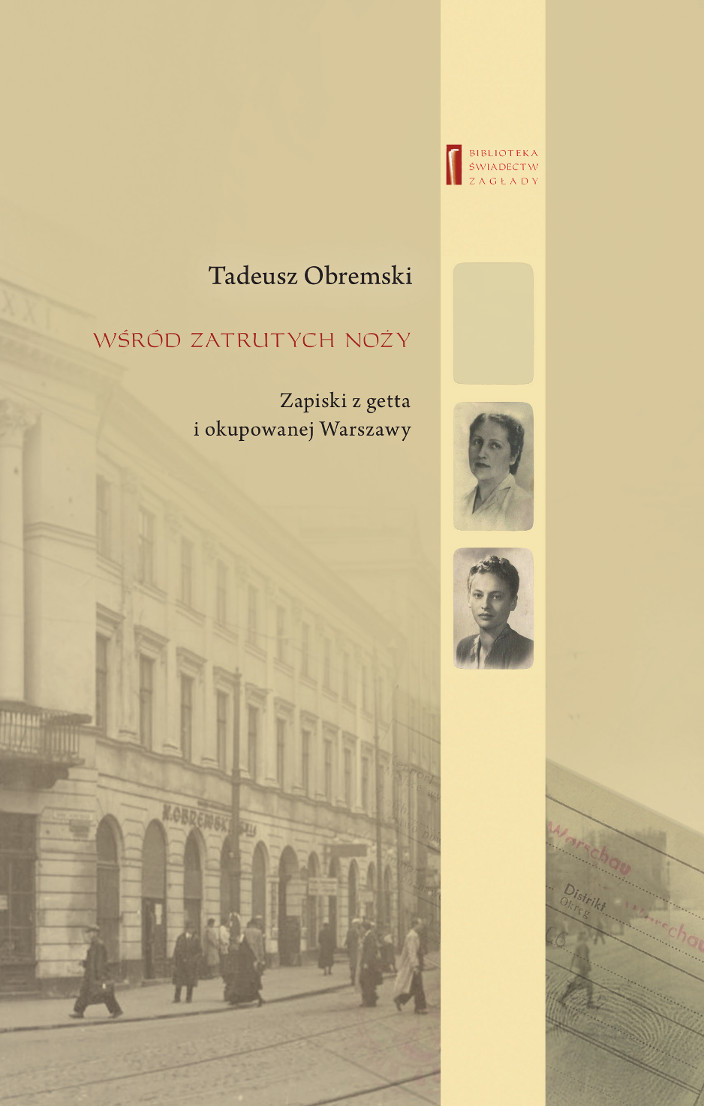 WŚRÓD ZATRUTYCH NOŻY ...
WŚRÓD ZATRUTYCH NOŻY ...
Zapiski z getta i okupowanej Warszawy
Tadeusz Obremski, oprac. i wstępem opatrzyła Agnieszka Haska
Warszawa 2017
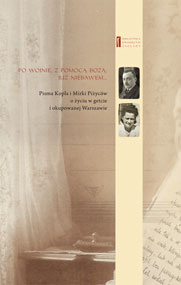 PO WOJNIE, Z POMOCĄ BOŻĄ, JUŻ NIEBAWEM ...
PO WOJNIE, Z POMOCĄ BOŻĄ, JUŻ NIEBAWEM ...
Pisma Kopla i Mirki Piżyców o życiu w getcie i okupowanej Warszawie
oprac. i wstępem opatrzyła Barbara Engelking i Havi Dreifuss
Warszawa 2017
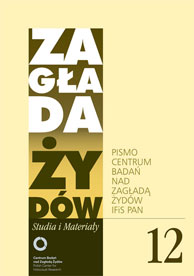 Zagłada Żydów.
Zagłada Żydów.
Studia i Materiały
nr 12, R. 2016
Warszawa 2016
.jpg) SNY CHOCIAŻ MAMY WSPANIAŁE ...
SNY CHOCIAŻ MAMY WSPANIAŁE ...
Okupacyjne dzienniki Żydów z okolic Mińska Mazowieckiego
oprac. i wstępem opatrzyła Barbara Engelking
Warszawa 2016
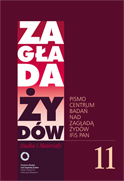 Zagłada Żydów.
Zagłada Żydów.
Studia i Materiały
nr 11, R. 2015
Warszawa 2015
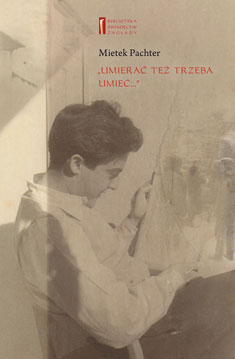 Mietek Pachter
Mietek Pachter
UMIERAĆ TEŻ TRZEBA UMIEĆ ...
oprac. B. Engelking
Warszawa 2015
 Zagłada Żydów.
Zagłada Żydów.
Studia i Materiały
nr 10, t. I-II, R. 2014
Warszawa 2015
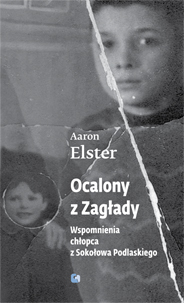 OCALONY Z ZAGŁADY
OCALONY Z ZAGŁADY
Wspomnienia chłopca z Sokołowa Podlaskiego
tłum. Elżbieta Olender-Dmowska
red .B. Engelking i J. Grabowski
Warszawa 2014
 ZAGŁADA ŻYDÓW. STUDIA I MATERIAŁY
ZAGŁADA ŻYDÓW. STUDIA I MATERIAŁY
vol. 9 R. 2013
Pismo Centrum Badań nad Zagładą Żydów IFiS PAN
Warszawa 2013
 ... TĘSKNOTA NACHODZI NAS JAK CIĘŻKA CHOROBA ...
... TĘSKNOTA NACHODZI NAS JAK CIĘŻKA CHOROBA ...
Korespondencja wojenna rodziny Finkelsztejnów, 1939-1941
oprac. i wstępem opatrzyła Ewa Koźmińska-Frejlak
Warszawa 2012
Raul Hilberg
PAMIĘĆ I POLITYKA. Droga historyka Zagłady
tłum. Jerzy Giebułtowski
Warszawa 2012
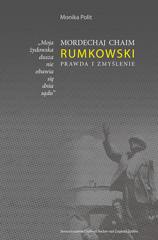 Monika Polit
Monika Polit
"Moja żydowska dusza nie obawia się dnia sądu."
Mordechaj Chaim Rumkowski. Prawda i zmyślenie
Warszawa 2012
.jpg) Dariusz Libionka i Laurence Weinbaum
Dariusz Libionka i Laurence Weinbaum
Bohaterowie, hochsztaplerzy, opisywacze. Wokół Żydowskiego Związku Wojskowego
Warszawa 2011
.jpg) Zagłada Żydów.
Zagłada Żydów.
Studia i Materiały
R. 2011, nr. 7; Warszawa 2011
.jpg) Jan Grabowski
Jan Grabowski
JUDENJAGD. Polowanie na Żydów 1942.1945.
Studium dziejów pewnego powiatu
Warszawa 2011
.jpg) Stanisław Gombiński (Jan Mawult)
Stanisław Gombiński (Jan Mawult)
Wspomnienia policjanta z warszawskiego getta
oprac. i wstęp Marta Janczewska
Warszawa 2010
Holocaust Studies and Materials
Journal of the Polish Center for Holocaust Research
Warssaw 2010
.jpg) Żydów łamiących prawo należy karać śmiercią!
Żydów łamiących prawo należy karać śmiercią!
"Przestępczość" Żydów w Warszawie, 1939-1942
B. Engelking, J. Grabowski
Warszawa 2010
Zagłada Żydów.
Studia i Materiały
R. 2010, nr. 6; Warszawa 2010
Wybór źródeł do nauczania o zagładzie Żydów
Ćwiczenia ze źródłami
red. A. Skibińska, R. Szuchta
Warszawa 2010
.jpg) W Imię Boże!
W Imię Boże!
Cecylia Gruft
oprac. i wstęp Łukasz Biedka
Warszawa 2009
Zagłada Żydów.
Studia i Materiały
R. 2009, nr. 5; Warszawa 2009
.jpg) Żydzi w powstańczej Warszawie
Żydzi w powstańczej Warszawie
Barbara Engelking i Dariusz Libionka
Warszawa 2009
 Reportaże z warszawskiego getta
Reportaże z warszawskiego getta
Perec Opoczyński
Warszawa 2009
 Notatnik
Notatnik
Szmul Rozensztajn
Warszawa 2008
.jpg) Holocaust
Holocaust
Studies and Materials.
English edition
2008, vol. 1; Warsaw 2008
.jpg) Źródła do badań nad zagładą Żydów na okupowanych ziemiach polskich
Źródła do badań nad zagładą Żydów na okupowanych ziemiach polskich
Przewodnik archiwalno-bibliograficzny
Alina Skibińska, wsp. Marta Janczewska, Dariusz Libionka, Witold Mędykowski, Jacek Andrzej Młynarczyk, Jakub Petelewicz, Monika Polit
Warszawa 2007
Zagłada Żydów. Studia i Materiały
R. 2007, nr. 3; Warszawa 2007
Prowincja noc.
Życie i zagłada Żydów w dystrykcie warszawskim
Warszawa 2007
.jpg) Utajone miasto.
Utajone miasto.
Żydzi po 'aryjskiej' stronie Warszawy [1941-1944]
Gunnar S Paulsson
Kraków 2007
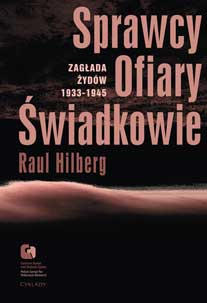 Sprawcy, Ofiary, Świadkowie.
Sprawcy, Ofiary, Świadkowie.
Zagłada Żydów, 1933-1944
Raul Hilberg
Warszawa 2007
Zagłada Żydów. Studia i Materiały
R. 2006, nr. 2; Warszawa 2006
"Jestem Żydem, chcę wejść!".
Hotel Polski w Warszawie, 1943.
Agnieszka Haska
Warszawa 2006
Zagłada Żydów. Studia i Materiały
R. 2005, nr. 1; Warszawa 2005
.jpg) 'Ja tego Żyda znam!'
'Ja tego Żyda znam!'
Szantażowanie Żydów w Warszawie, 1939-1943.
Jan Grabowski
Warszawa 2004
 'Szanowny panie Gistapo!'
'Szanowny panie Gistapo!'
Donosy do władz niemieckich w Warszawie i okolichach, 1940-1941
Barbara Engelking, Warszawa 2003
aaa
 Zagłada Żydów.
Zagłada Żydów.
Studia i Materiały
nr 18, R. 2022
Warszawa 2022
 PAMIĘTNIK
PAMIĘTNIK
Kalman Rotgeber
oprac. Aleksandra Bańkowska, wstęp Jacek Leociak
Warszawa 2021
Zagłada Żydów.
Studia i Materiały
nr 17, R. 2021
Warszawa 2021
 NIE WIEMY CO PRZYNIESIE NAM KOLEJNA GODZINA ...
NIE WIEMY CO PRZYNIESIE NAM KOLEJNA GODZINA ...
Dziennik pisany w ukryciu w latach 1943-1944
Moszek Baum, oprac. Barbara Engelking, tłum. z jidysz Monika Polit
Warszawa 2020
Zagłada Żydów.
Studia i Materiały
nr 16, R. 2020
Warszawa 2020
.jpg) Aryjskiego Żyda wspomnienia, łzy i myśli
Aryjskiego Żyda wspomnienia, łzy i myśli
Zapiski z okupacyjnej Warszawy
Sewek Okonowski, oprac. Marta Janczewska
 PISZĄCY TE SŁOWA JEST PRACOWNIKIEM
PISZĄCY TE SŁOWA JEST PRACOWNIKIEM
GETTOWEJ INSTYTUCJI ...
'z Dziennika' i inne pisma z łódzkiego getta
Józef Zelkowicz, tłum. z jidysz, oprac. i wstęp. Monika Polit
Warszawa 2019
CZYTAJĄC GAZETĘ NIEMIECKĄ ...
Dziennik pisany w ukryciu w Warszawie w latach 1943-1944
Jakub Hochberg, oprac. i wstępem opatrzyła Barbara Engelking
Warszawa 2019
Zagłada Żydów.
Studia i Materiały
nr 15, R. 2019
Warszawa 2019
.jpg) Zagłada Żydów.
Zagłada Żydów.
Studia i Materiały
nr 14, R. 2018
Warszawa 2018
 DALEJ JEST NOC. Losy Żydów w wybranych powiatach okupowanej Polski
DALEJ JEST NOC. Losy Żydów w wybranych powiatach okupowanej Polski
red. i wstęp Barbara Engelking, Jan Grabowski
Warszawa 2018
 ŻADNA BLAGA, ŻADNE KŁAMSTWO ...
ŻADNA BLAGA, ŻADNE KŁAMSTWO ...
Wspomnienia z warszawskiego getta
Stanisław Adler, oprac. i wstępem opatrzyła Marta Janczewska
Warszawa 2018
 Zagłada Żydów.
Zagłada Żydów.
Studia i Materiały
nr 13, R. 2017
Warszawa 2017
 TYLEŚMY JUŻ PRZESZLI ...
TYLEŚMY JUŻ PRZESZLI ...
Dziennik pisany w bunkrze (Żółkiew 1942-1944)
Clara Kramer, oprac. i wstępem opatrzyła Anna Wylegała
Warszawa 2017
 WŚRÓD ZATRUTYCH NOŻY ...
WŚRÓD ZATRUTYCH NOŻY ...
Zapiski z getta i okupowanej Warszawy
Tadeusz Obremski, oprac. i wstępem opatrzyła Agnieszka Haska
Warszawa 2017
 PO WOJNIE, Z POMOCĄ BOŻĄ, JUŻ NIEBAWEM ...
PO WOJNIE, Z POMOCĄ BOŻĄ, JUŻ NIEBAWEM ...
Pisma Kopla i Mirki Piżyców o życiu w getcie i okupowanej Warszawie
oprac. i wstępem opatrzyła Barbara Engelking i Havi Dreifuss
Warszawa 2017
 Zagłada Żydów.
Zagłada Żydów.
Studia i Materiały
nr 12, R. 2016
Warszawa 2016
.jpg) SNY CHOCIAŻ MAMY WSPANIAŁE ...
SNY CHOCIAŻ MAMY WSPANIAŁE ...
Okupacyjne dzienniki Żydów z okolic Mińska Mazowieckiego
oprac. i wstępem opatrzyła Barbara Engelking
Warszawa 2016
 Zagłada Żydów.
Zagłada Żydów.
Studia i Materiały
nr 11, R. 2015
Warszawa 2015
 Mietek Pachter
Mietek Pachter
UMIERAĆ TEŻ TRZEBA UMIEĆ ...
oprac. B. Engelking
Warszawa 2015
 Zagłada Żydów.
Zagłada Żydów.
Studia i Materiały
nr 10, t. I-II, R. 2014
Warszawa 2015
 OCALONY Z ZAGŁADY
OCALONY Z ZAGŁADY
Wspomnienia chłopca z Sokołowa Podlaskiego
tłum. Elżbieta Olender-Dmowska
red .B. Engelking i J. Grabowski
Warszawa 2014
 ZAGŁADA ŻYDÓW. STUDIA I MATERIAŁY
ZAGŁADA ŻYDÓW. STUDIA I MATERIAŁY
vol. 9 R. 2013
Pismo Centrum Badań nad Zagładą Żydów IFiS PAN
Warszawa 2013
 ... TĘSKNOTA NACHODZI NAS JAK CIĘŻKA CHOROBA ...
... TĘSKNOTA NACHODZI NAS JAK CIĘŻKA CHOROBA ...
Korespondencja wojenna rodziny Finkelsztejnów, 1939-1941
oprac. i wstępem opatrzyła Ewa Koźmińska-Frejlak
Warszawa 2012
Raul Hilberg
PAMIĘĆ I POLITYKA. Droga historyka Zagłady
tłum. Jerzy Giebułtowski
Warszawa 2012
 Monika Polit
Monika Polit
"Moja żydowska dusza nie obawia się dnia sądu."
Mordechaj Chaim Rumkowski. Prawda i zmyślenie
Warszawa 2012
.jpg) Dariusz Libionka i Laurence Weinbaum
Dariusz Libionka i Laurence Weinbaum
Bohaterowie, hochsztaplerzy, opisywacze. Wokół Żydowskiego Związku Wojskowego
Warszawa 2011
.jpg) Zagłada Żydów.
Zagłada Żydów.
Studia i Materiały
R. 2011, nr. 7; Warszawa 2011
.jpg) Jan Grabowski
Jan Grabowski
JUDENJAGD. Polowanie na Żydów 1942.1945.
Studium dziejów pewnego powiatu
Warszawa 2011
.jpg) Stanisław Gombiński (Jan Mawult)
Stanisław Gombiński (Jan Mawult)
Wspomnienia policjanta z warszawskiego getta
oprac. i wstęp Marta Janczewska
Warszawa 2010
Holocaust Studies and Materials
Journal of the Polish Center for Holocaust Research
Warssaw 2010
.jpg) Żydów łamiących prawo należy karać śmiercią!
Żydów łamiących prawo należy karać śmiercią!
"Przestępczość" Żydów w Warszawie, 1939-1942
B. Engelking, J. Grabowski
Warszawa 2010
Zagłada Żydów.
Studia i Materiały
R. 2010, nr. 6; Warszawa 2010
Wybór źródeł do nauczania o zagładzie Żydów
Ćwiczenia ze źródłami
red. A. Skibińska, R. Szuchta
Warszawa 2010
.jpg) W Imię Boże!
W Imię Boże!
Cecylia Gruft
oprac. i wstęp Łukasz Biedka
Warszawa 2009
Zagłada Żydów.
Studia i Materiały
R. 2009, nr. 5; Warszawa 2009
.jpg) Żydzi w powstańczej Warszawie
Żydzi w powstańczej Warszawie
Barbara Engelking i Dariusz Libionka
Warszawa 2009
 Reportaże z warszawskiego getta
Reportaże z warszawskiego getta
Perec Opoczyński
Warszawa 2009
 Notatnik
Notatnik
Szmul Rozensztajn
Warszawa 2008
.jpg) Holocaust
Holocaust
Studies and Materials.
English edition
2008, vol. 1; Warsaw 2008
.jpg) Źródła do badań nad zagładą Żydów na okupowanych ziemiach polskich
Źródła do badań nad zagładą Żydów na okupowanych ziemiach polskich
Przewodnik archiwalno-bibliograficzny
Alina Skibińska, wsp. Marta Janczewska, Dariusz Libionka, Witold Mędykowski, Jacek Andrzej Młynarczyk, Jakub Petelewicz, Monika Polit
Warszawa 2007
Zagłada Żydów. Studia i Materiały
R. 2007, nr. 3; Warszawa 2007
Prowincja noc.
Życie i zagłada Żydów w dystrykcie warszawskim
Warszawa 2007
.jpg) Utajone miasto.
Utajone miasto.
Żydzi po 'aryjskiej' stronie Warszawy [1941-1944]
Gunnar S Paulsson
Kraków 2007
 Sprawcy, Ofiary, Świadkowie.
Sprawcy, Ofiary, Świadkowie.
Zagłada Żydów, 1933-1944
Raul Hilberg
Warszawa 2007
Zagłada Żydów. Studia i Materiały
R. 2006, nr. 2; Warszawa 2006
"Jestem Żydem, chcę wejść!".
Hotel Polski w Warszawie, 1943.
Agnieszka Haska
Warszawa 2006
Zagłada Żydów. Studia i Materiały
R. 2005, nr. 1; Warszawa 2005
.jpg) 'Ja tego Żyda znam!'
'Ja tego Żyda znam!'
Szantażowanie Żydów w Warszawie, 1939-1943.
Jan Grabowski
Warszawa 2004
 'Szanowny panie Gistapo!'
'Szanowny panie Gistapo!'
Donosy do władz niemieckich w Warszawie i okolichach, 1940-1941
Barbara Engelking, Warszawa 2003
aaa
Nowy Swiat St. 72, 00-330 Warsaw; POLAND;
Palac Staszica room 120
e-mail: centrum@holocaustresearch.pl
NIGHT WITHOUT END - Failed correctiion - Dagmara Swaltek-Niewinska
Dagmara Swałtek-Niewinska see in PDF![]()
Institute of Philosophy and Sociology of the Polish Academy of Sciences
centrum@holocaustresearch.pl
Response to the Review
by Tomasz Domański Entitled Correcting the Picture? Reflections on the Sources Used in "Night Without an End. Fate of Jews in Selected Counties of Occupied Poland"”1]
(Polish-Jewish Studies, Institute of National Remembrance [Warsaw, 2019])
At first glance, Tomasz Domański’s extensive review of our book Night Without an End. Fate of Jews in Selected Counties of Occupied Poland seems to be written by an expert. In fact, however, it contributes surprisingly little. A more thorough reading of the review proves that Domański read our book carelessly and selectively. Let me address the most serious accusations he formulates against my chapter devoted to Bochnia county.
His first and primary accusation concerns the selection of the research territory. Domański disproves of the fact that some of us chose pre-war counties, while others focused on wartime counties. Moreover, he writes about that decision in a sensational vein, as if he made a significant discovery and proved a manipulation. During the occupation, pre-war Bochnia county, which I studied, belonged to Kreishauptmannschaft Krakau-Land. I selected that particular research territory for specific reasons. The Kreishauptmannschaft bordered the city of Krakow, the capital of the General Government. Localities such as Wieliczka situated several kilometers from Cracow, were characterized by different social relations than the terrains more distant from the city, which made up pre-war Bochnia county. After the resettlement of Jews from Cracow, which was conducted from the summer of 1940 to the spring of 1941, most Jews living in localities near Krakow were refugees from the General Government’s capital. Their survival strategies were to a large extent connected with Krakow, as a big city provided different rescue opportunities. Consequently, researching the entire Kreis would have largely come down to analyzing the fate of the Jews in Krakow. I wished to avoid that, since our project’s intention was to carry out research on smaller towns and villages. . Due to those factors, which influenced survival strategies in the former Bochnia county and pre-war Krakow county, I decided to discuss only the former. Another argument was the certain administrative separateness of that terrain. The territory of the pre-war county was administered by the plenipotentiary (Landkommissar) seated in Bochnia, who was subordinate to the county governor (Kreishauptmmann) and was partly in charge of Jewish affairs on his behalf.
The counties selected by members of our research team differed in many respects, some of which were evident at first glance (size, population density, geographic factors, or pre-war ethnic composition). However, some of the counties proved different only after the research began. For instance, one of the characteristic features of Bochnia as a town was the corruption of the local German police chief, Wilhelm Schömburg, which was exceptional even for the reality of the occupation period. In return for bribes, he was willing to legalize falsified documents and up to a point turn a blind eye to some instances of breaking the law. Along with other characteristics of the researched territory, this contributed to an influx of Jews into the town. This, among other factors, resulted in a conviction, later expressed in many testimonies, that up to the liquidation of the Bochnia Ghetto it was a place safer for Jews than other towns. Furthermore, in the summer of 1943 the town became the organizational center for escapes to Hungary across the Podhale region, the Sądecczyzna region, and Slovakia. I regard my choice of pre-war Bochnia county as justified, as it enabled me to present various types of the Jews’ survival strategies stemming from the local situation.
In his review, Domański accuses us of selecting counties which are not representative of occupied Poland. I am afraid that this accusation stems from the fact that Domański is somewhat unfamiliar with the principles of statistics and the selection of a research area. It is impossible to select a fully representative group of 9 prewar or wartime counties. To get a full picture of occupied Poland (or at least the General Government), one would have to use a similar method to carry out research on all occupied territories.
While the reviewer’s question about our criteria of county selection seems justified, his next reservations about the book’s content mostly stem from erroneous interpretations, omissions, and a distortion of the written text. Domański then goes on to fight the enemy he conjured, referring not to the contents of our two volumes, but to his own interpretations, many of which are invalid. To that end, he uses a simple device: he attributes certain opinions or conclusions to the authors and then illustrates them with citations which seemingly confirm his interpretation. One example is the topic of the blue police. Domański criticizes the authors: “They paint its [the blue police – D. S.] picture as if it had truly been an element of the functioning of the Polish state by the Germans’ side. In many places the blue police’s existence side by side with the German functionaries is presented as based on the principle of partnership, equality, or even autonomy — as a manifestation of the operation of the Polish police in the full and official meaning of this word. This can make less knowledgeable readers think that that uniform formation was really a structure of the Polish state which was more or less (actually: more) autonomous from the Germans” (Domański 10).
Domański illustrates his thesis with, for instance, the accusation that I used a quotation from a witness of the execution of the Fragner family. For Antoni Łucki testified that it was conducted by “the blue police with the participation of one German.” The reviewer apparently did not notice that another quotation in that chapter (taken from Mieczysław Ledóchowski’s recollections) discusses the same situation: “On the road near our presbytery two German policemen from Bochnia (one was named Beck, and the other one Szindler) executed the five-person family of a Jewish attorney from Wiśnicz, who were hiding in the Lipnica forest and were captured. The bodies of the murdered lay in the ditch by the road on Lipnica’s border to discourage the Polish population from helping Jews” (Swałtek-Niewińska, vol. 2, 571–572). Although the second testimony completes the picture of the events, Domański ignores it.
As for the nationality of the executioners of the captured Jews, on the territory which I researched most of the executioners were German gendarmes and I did write that in my text on more than one occasion (Swałtek-Niewińska, vol. 2, 559, 614). In the appendix I also included a long record of an interview with a gravedigger from Bochnia, Henryk Groblicki, who witnessed numerous executions conducted by the gendarmerie (638–639). This does not change the fact that in many instances the arrest of the Jews in hiding was facilitated by the network of local informers, agents, and occasional denouncers.
I cannot agree with the reviewer’s impression that we claim and suggest that the occupation period Polish Police was “a structure of the Polish state […] autonomous from the Germans” (Domański 10). To a reader who has some knowledge of World War II, it is obvious that the Polish Police, that is, Polnische Polizei, was established to realize the objectives and carry out orders of the German occupation authorities. But the reality was more complex than Tomasz Domański thinks. In Adam Hempel’s monograph on the blue police (idem, Pogrobowcy klęski. Rzecz o policji „granatowej” w Generalnym Gubernatorstwie 1939–1945 [Warsaw, 1990]), which is not free of mistakes and simplifications but remains the only monograph on this topic, the author proved that most functionaries of the occupation period Polish Police were pre-war Polish policemen. Although those cadres were then gradually supplemented with new employees, they remained made up predominantly of Poles. These findings are confirmed in our research on the counties. Consequently, on the one hand, the term ‘Polish policeman’ denotes a member of a specific formation (blue police, Polish Police, Polnische Polizei), and on the other hand, it serves as a description of the ethnicity and function. In the latter case it is analogous to the expression ‘German policeman’, which in the context of my county almost always referred to gendarmes, although in the testimonies and accounts it might have also referred to functionaries of other police formations in which ethnic Germans served (for instance, Bahnschutz).
Is Tomasz Domański right when he claims that the analysis of the actions of Polish policemen does not broaden our knowledge about the participation of some Poles in the killing of Jews? In my opinion he is not. Our book presents many highly detailed descriptions which had never been published, but this is not what constitutes its main value. Research on the microhistorical level makes it possible to present two perspectives: an analysis of actions on the level of the institution, here a police formation (the Polish Police under German orders), and also on the level of individual actions and decisions, which might have been different than the goals set by the decision makers. They should not be reduced to simplistic black-and-white depictions. Our attempt to understand the topic on a deeper level enabled us to discern trends and regularities. Hence the conclusion that the blue police played an important role in the tracking down of the Jews who were trying to survive on the given territory. At the same time there are isolated cases of Polish policemen such as Andrzej Ludwikowski, whom I discussed in my chapter. Ludwikowski helped Jews in hiding in the vicinity of Nowy Wiśnicz, including Hillel Wodzisławski, and eventually deserted from service in 1943. In my opinion this is a very important element of which we must not lose sight in our discussions about attitudes during the occupation; even in the darkest moments and in the worst possible conditions one makes decisions for which one is personally responsible.
I also think that Domański’s attempt to interpret the entire book in the context of Polish-Jewish relations is misguided. Of course, as a reader he has a right to deem this thread the most interesting or crucial, but let me repeat that our book is not about Polish-Jewish relations or Polish attitudes towards Jews. And it is definitely not an attempt to paint a full picture of the reality of the occupation period. Our main topic was the fate and the survival strategies of the Jews hiding in the selected territories. Consequently, questions about what motivated specific Polish policemen were not our priority. More important was the conclusion that for a Jew in hiding an encounter with a Polish policeman almost always ended in death. Polish policemen were regarded as highly dangerous because they were an effective instrument in the hands of the occupation authorities. As Poles, they could tell who was speaking Polish without a foreign accent, they were familiar with the local situation and had contacts within the local population.
I agree with the reviewer that the policemen implemented German policy and participated in the persecution of ethnic Poles. At the same time, their basic task was keeping order, that is, protection from crime. The local population treated them partially as ‘their own’; unlike the Germans, they were not unambiguously classified as the enemy. In the files of the post-war trials one can find explanations given by former policemen who justified the murders of Jews in hiding with the intention to protect the Polish population and fear that if the Jews were captured by the German police the Poles who sheltered them would die too. Such a justification for the murders is not devoid of logic. The documents and testimonies should be read predominantly as a evidence of the criminal system, which used propaganda as well as the threat of punishment to gradually involve more and more people in crime.
Domański approached the topic of the Baudienst (Construction Service) in a similarly sensational tone. He accused us of concealing from our readers that it was a formation which conscripted young men under threat of punishment, including capital punishment (13–14). This is a result of the reviewer’s careless reading of the text, since in my chapter I do write the following: “It should be stressed that refusal to render work for the Baudienst could result in severe punishment and that desertion could end in deportation to a camp or death” (Swałtek-Niewińska, vol. 2, 548, footnote 64). Carried away by emotions, Domański went as far as stating: “It is a form of falsification of history to present their forced participation in the actions accompanying the Holocaust almost as actions undertaken from the young people’s own volition” (14). For example, in my text one can find a description of what the preparation for and the supervision over the Baudienst laborers looked like. They were sent to dig pits in Baczków by their German supervisors, and it was not until the day of the execution of Jews that they learned that it would be conducted (Swałtek-Niewińska, vol. 2, 548).
On several occasions, Domański accuses our study of not presenting a full picture of the reality of the occupation period. I think that this a result of his misunderstanding of the topic of our book, which I tried to explain above. There is a great need for syntheses of the fate of the Polish and Jewish population under the occupation and the functioning of the local administration in occupied Poland, but writing such a monograph was not an intention of the authors of Night Without an End. A disciplined scholar, be a historian or a sociologist, is required to write on the topic of one’s study. One cannot pour out everything one knows about the given period or place like in a stream of consciousness. The length of the review seems to suggest that Domański has trouble presenting his key thoughts in a concise text and that he is trying to include absolutely every piece of information he accessed. For instance, one can wonder why his review contains reflections on the situation in the Polish countryside based on widely available literature (18–20). The bibliographic references included in the volumes prove that we are familiar with these publications. Consequently, the reviewer’s remarks do not broaden our knowledge in any way. Perhaps Domański’s intention was to inform a less knowledgeable reader, but how many of them will read a review of a scholarly study? This kind of information could be put to better use in an article or a monograph, while the review should have simply referred to the reviewed book.
In some fragments of the review, the author voices certain postulates because he clearly failed to notice that they were implemented in our book. For instance, Domański included a long passage accusing us of failing to consider the context of looting and greed: “The authors do not ask themselves research questions regarding the similarities between other people’s property (not only Jewish property) which was looted both in and outside the ghettos when it was left unprotected” (20). In fact, even in my chapter one can find a suitable example — the description of the looting of an aircraft shot down by the Germans which was flying to help fighting Warsaw in August 1944: “At the same time one cannot explain the lack of scruples about looting exclusively with anti-Semitism. It seems that the general wartime moral corruption constituted a more important factor” (Swałtek-Niewińska, vol. 2, 568, footnote 126). I must admit that I am perplexed with how carelessly Domański read the study he is reviewing. For instance, he also accuses me of failing to mention the smuggling of food into the Bochnia ghetto, even though this issue is mentioned in one of the post-war testimonies (23). I hope that Tomasz Domański is aware that in my 100-page-long text I could not cite every source I read. While working on my text I browsed through thousands of pages of various kinds of documents and I had to select the examples presenting certain types of reactions to the occupation period reality. I did mention Romek Marber’s Catholic friend who helped smuggle food into the Bochnia ghetto (Swałtek-Niewińska, vol. 2, 535–536). I also wrote about other positive examples of relations between Poles and Jews during the period preceding the closure of the ghetto. The example of the Łacny family from the vicinity of Wiśnicz seemed particularly interesting and worthy of emphasis — the Łacnys had Jewish tenants before 1942 and after the extermination campaigns they kept helping Jews in need (Swałtek-Niewińska, vol. 2, 537).
The next issue I wish to discuss is the fact that Domański accused me of a manipulation of sources (Domański 58). This is a very serious accusation against a scholar and one should not voice it in such a carefree way even when swept up by journalistic emotions. This is the fragment of the text which the reviewer thinks controversial: “The resettlement on 22 August 1942 was conducted under the blue police’s supervision, without the participation of German functionaries. Anna Steinberg remembered the local Polish police commander, Jan Ratajczak, in a particularly negative way as he was threatening to execute the Jews, brandishing a revolver and hitting people” (Swałtek-Niewińska, vol. 2, 575). Domański accuses me of failing to inform the reader that the Jewish police were present at the scene, which Steinberg does mention in her testimony. But that information had little importance, because Ratajczak was the main person described in the context of the deportation from Niepołomice. In this sentence I do not refer to the behavior of other policemen and their participation in the deportation campaign in that locality. In the worst case scenario I could accuse myself of imprecision, since with a large dose of ill will this sentence can be read as a suggestion that Steinberg regarded Ratajczak as a particularly negative individual among the Polish policemen (which supposedly means that others also behaved inappropriately).
One of the characteristic features of Tomasz Domański’s text is the eagerness with which he looks for manipulations. He rightly mentions Frisch’s case in the context of the post-war evaluations of people who took part in searching for people hiding in bunkers, but he approaches the witnesses’ testimonies uncritically (59). For instance, he quotes the figure 800–1,000 as the purported number of people who, in the opinion of a witness, were hiding in bunkers. This figure is completely unrealistic however, as clearly proved by a comparison of the number of ghetto residents before the liquidation action with the number of people deported to Auschwitz, Płaszów, and Szebnie, which is included in my text.
Summarizing the reading prompts me to the sad conclusion that one can write a review which is over 70 pages long but contributes little to the discussion about the fate of the Jewish population in occupied Poland. In the year since the publication of Night Without an End, I have had numerous conversations with people who are in some way interested in this topic, usually because of certain family connections with the area I studied. Owing to those contacts I gained access to documents in private possession, for which I am extremely grateful as I will use them in my future research. I also encountered critical remarks and ideas for other possible interpretations offered by both inhabitants of Bochnia county and my colleagues — sociologists and historians. I approach these words with humility and I even welcome them because nothing incites one more to scholarly work than constructive criticism. I believe that reviews of publications which present research results should be aimed at broadening our knowledge. If that was the objective of Tomasz Domański’s review, then his long text contributes very little. I found no guidelines or corrections in terms of the sources or methodology used. I am convinced, however, that this review will be used as instrument in the ongoing journalistic and political discussion.
[1] Tomasz Domański, Korekta obrazu? Refleksje źródłoznawcze wokół książki Dalej jest noc. Losy Żydów w wybranych powiatach okupowanej Polski, https://ipn.gov.pl/pl/aktualnosci/65746,Korekta-obrazu-Refleksje-zrodloznawcze-wokol-ksiazki-Dalej-jest-noc-Losy-Zydow-w.html, access 14 March 2019. As the English translation of this brochure has not been published yet, the page numbers refer to its Polish edition, with the quotations translated by the translator of this review. (translator’s footnote)



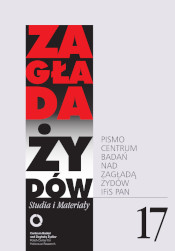

.jpg)
.jpg)


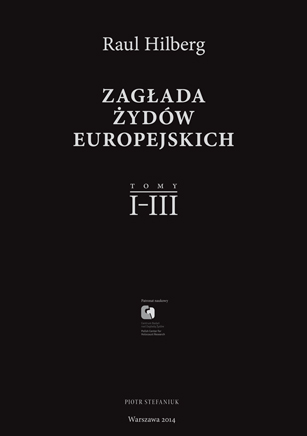
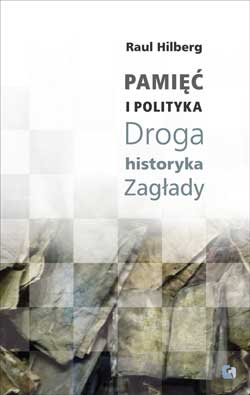
.jpg)
.jpg)
.jpg)
.jpg)
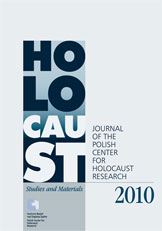

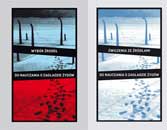
.jpg)
.jpg)
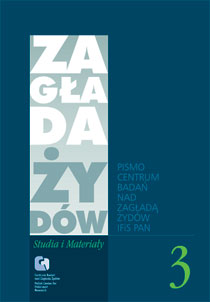
.jpg)
